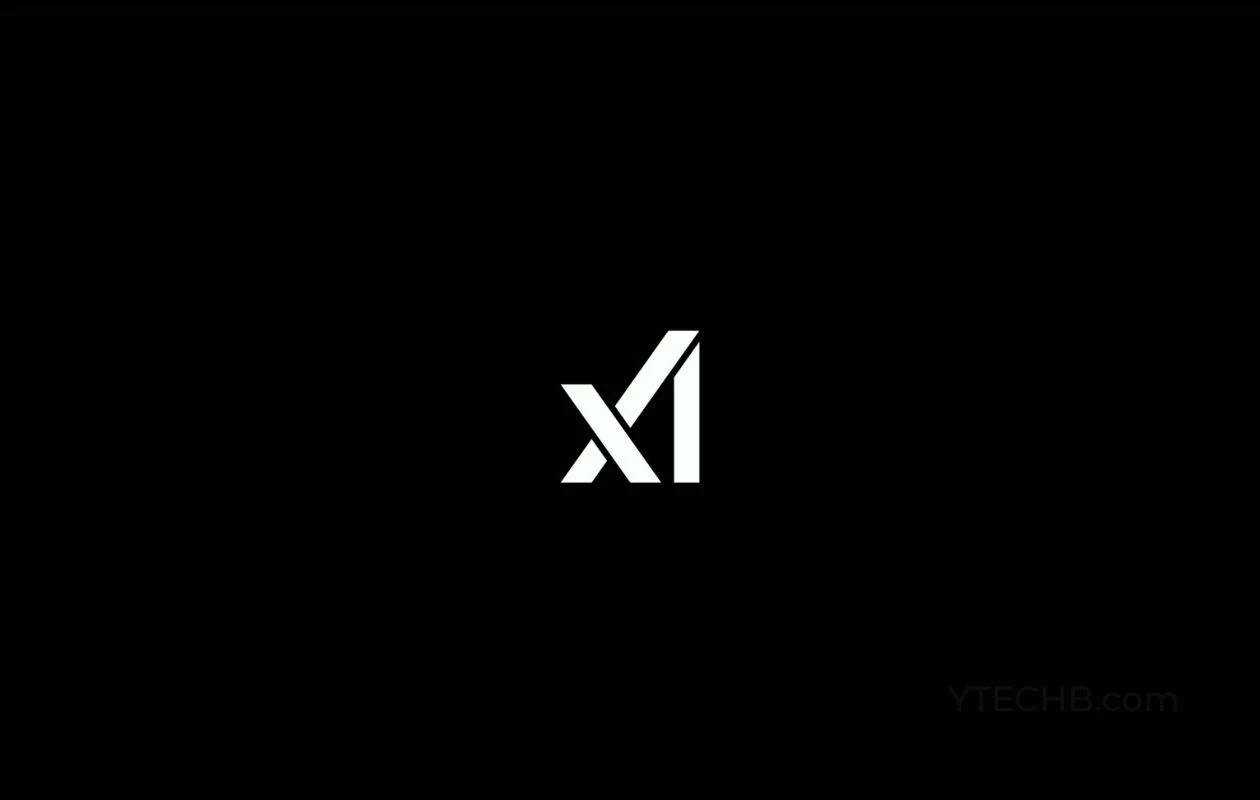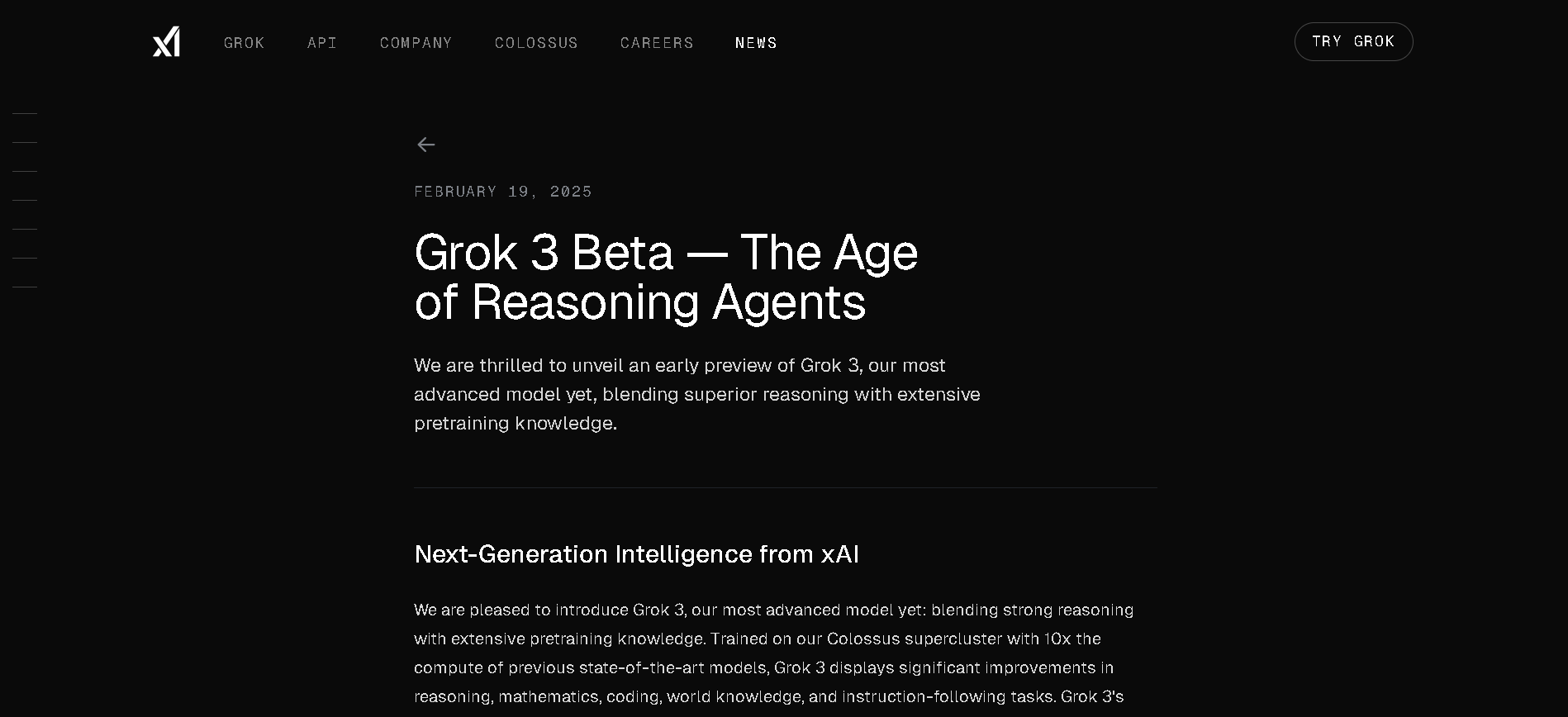
- Developers & Engineers: Embed fast, transparent reasoning into chatbots or interactive pipelines.
- Students & Educators: Provide on-demand step-by-step logic for math, coding, and analysis.
- Enterprises & SMEs: Deploy reasoning-capable AI affordably for live Q&A or transaction flows.
- Content & Tooling Teams: Automate structured reasoning tasks—debugging, summaries, workflows.
- Researchers: Benchmark transparent chain-of-thought performance in real-world, low-latency settings.
How to Use Grok 3 Mini Fast (Latest)?
- Access via xAI API or Oracle Cloud: Use model ID `grok-3-mini-fast-beta` in supported regions (e.g. US Midwest).
- Include Prompts with “Think”: Use reasoning prompts or set `"reasoning_effort": "high"` to trigger chain-of-thought output.
- Send Multimodal Inputs: Accepts text (and, where supported, images) up to 131,072 tokens.
- Experience Faster Output: Optimized infrastructure yields high throughput (
210 tokens/sec) with quick initial response (0.32 s). - Manage Cost: Input tokens
$0.60/M; output tokens$4.00/M—reflecting performance tier.
- Low-Latency Reasoning: Delivers real-time chain-of-thought insights using fast serving infrastructure.
- Feature-Parity with Mini: Maintains same reasoning quality, context window, and multimodal support as standard Mini.
- Large Context Scope: 131K-token window enables in-depth document, code, or conversation analysis.
- Optimized for Deployment: Ideal for interactive apps needing fast, interpretable AI.
- Premium Pricing Tier: Higher costs reflect the infrastructure advantages.
- Transparent chain-of-thought at low latency
- Same powerful reasoning in compact form
- High throughput (~210 tokens/sec) and fast start (~0.32 s)
- Large context window retained
- Integration via existing API clients or Oracle deployment
- More expensive: $0.60/$4.00 per million tokens vs standard Mini price
- Still in beta—features and cost may change
- Lacks “Big Brain” deep reasoning—only available in full flagship model
Free Tier
$ 0.00
Limited access to DeepSearch
Limited access to DeeperSearch
Super Grok
$30/month
More Aurora Images - 100 Images / 2h
Even Better Memory - 128K Context Window
Extended access to Thinking - 30 Queries / 2h
Extended access to DeepSearch - 30 Queries / 2h
Extended access to DeeperSearch - 10 Queries / 2h
API
$0.60/$4.00 per 1M tokens
Cached Input - $0.15/M
Output - $4.00/M
Proud of the love you're getting? Show off your AI Toolbook reviews—then invite more fans to share the love and build your credibility.
Add an AI Toolbook badge to your site—an easy way to drive followers, showcase updates, and collect reviews. It's like a mini 24/7 billboard for your AI.
Reviews
Rating Distribution
Average score
Popular Mention
FAQs
Similar AI Tools

GPT-4o Mini Realtime Preview is a lightweight, high-speed variant of OpenAI’s flagship multimodal model, GPT-4o. Built for blazing-fast, cost-efficient inference across text, vision, and voice inputs, this preview version is optimized for real-time responsiveness—without compromising on core intelligence. Whether you’re building chatbots, interactive voice tools, or lightweight apps, GPT-4o Mini delivers smart performance with minimal latency and compute load. It’s the perfect choice when you need responsiveness, affordability, and multimodal capabilities all in one efficient package.


OpenAI GPT 4o mini..
GPT-4o Mini Realtime Preview is a lightweight, high-speed variant of OpenAI’s flagship multimodal model, GPT-4o. Built for blazing-fast, cost-efficient inference across text, vision, and voice inputs, this preview version is optimized for real-time responsiveness—without compromising on core intelligence. Whether you’re building chatbots, interactive voice tools, or lightweight apps, GPT-4o Mini delivers smart performance with minimal latency and compute load. It’s the perfect choice when you need responsiveness, affordability, and multimodal capabilities all in one efficient package.


OpenAI GPT 4o mini..
GPT-4o Mini Realtime Preview is a lightweight, high-speed variant of OpenAI’s flagship multimodal model, GPT-4o. Built for blazing-fast, cost-efficient inference across text, vision, and voice inputs, this preview version is optimized for real-time responsiveness—without compromising on core intelligence. Whether you’re building chatbots, interactive voice tools, or lightweight apps, GPT-4o Mini delivers smart performance with minimal latency and compute load. It’s the perfect choice when you need responsiveness, affordability, and multimodal capabilities all in one efficient package.


OpenAI GPT 4o mini..
GPT-4o-mini-tts is OpenAI's lightweight, high-speed text-to-speech (TTS) model designed for fast, real-time voice synthesis using the GPT-4o-mini architecture. It's built to deliver natural, expressive, and low-latency speech output—ideal for developers building interactive applications that require instant voice responses, such as AI assistants, voice agents, or educational tools. Unlike larger TTS models, GPT-4o-mini-tts balances performance and efficiency, enabling responsive, engaging voice output even in environments with limited compute resources.


OpenAI GPT 4o mini..
GPT-4o-mini-tts is OpenAI's lightweight, high-speed text-to-speech (TTS) model designed for fast, real-time voice synthesis using the GPT-4o-mini architecture. It's built to deliver natural, expressive, and low-latency speech output—ideal for developers building interactive applications that require instant voice responses, such as AI assistants, voice agents, or educational tools. Unlike larger TTS models, GPT-4o-mini-tts balances performance and efficiency, enabling responsive, engaging voice output even in environments with limited compute resources.


OpenAI GPT 4o mini..
GPT-4o-mini-tts is OpenAI's lightweight, high-speed text-to-speech (TTS) model designed for fast, real-time voice synthesis using the GPT-4o-mini architecture. It's built to deliver natural, expressive, and low-latency speech output—ideal for developers building interactive applications that require instant voice responses, such as AI assistants, voice agents, or educational tools. Unlike larger TTS models, GPT-4o-mini-tts balances performance and efficiency, enabling responsive, engaging voice output even in environments with limited compute resources.


OpenAI GPT 4o mini..
GPT-4o-mini Search Preview is OpenAI’s lightweight semantic search feature powered by the GPT-4o-mini model. Designed for real-time applications and low-latency environments, it brings retrieval-augmented intelligence to any product or tool that needs blazing-fast, accurate information lookup. While compact in size, it offers the power of contextual understanding, enabling smarter, more relevant search results with fewer resources. It’s ideal for startups, embedded systems, or anyone who needs search that just works—fast, efficient, and tuned for integration.


OpenAI GPT 4o mini..
GPT-4o-mini Search Preview is OpenAI’s lightweight semantic search feature powered by the GPT-4o-mini model. Designed for real-time applications and low-latency environments, it brings retrieval-augmented intelligence to any product or tool that needs blazing-fast, accurate information lookup. While compact in size, it offers the power of contextual understanding, enabling smarter, more relevant search results with fewer resources. It’s ideal for startups, embedded systems, or anyone who needs search that just works—fast, efficient, and tuned for integration.


OpenAI GPT 4o mini..
GPT-4o-mini Search Preview is OpenAI’s lightweight semantic search feature powered by the GPT-4o-mini model. Designed for real-time applications and low-latency environments, it brings retrieval-augmented intelligence to any product or tool that needs blazing-fast, accurate information lookup. While compact in size, it offers the power of contextual understanding, enabling smarter, more relevant search results with fewer resources. It’s ideal for startups, embedded systems, or anyone who needs search that just works—fast, efficient, and tuned for integration.


OpenAI Codex mini ..
codex-mini-latest is OpenAI’s lightweight, high-speed AI coding model, fine-tuned from the o4-mini architecture. Designed specifically for use with the Codex CLI, it brings ChatGPT-level reasoning directly to your terminal, enabling efficient code generation, debugging, and editing tasks. Despite its compact size, codex-mini-latest delivers impressive performance, making it ideal for developers seeking a fast, cost-effective coding assistant.


OpenAI Codex mini ..
codex-mini-latest is OpenAI’s lightweight, high-speed AI coding model, fine-tuned from the o4-mini architecture. Designed specifically for use with the Codex CLI, it brings ChatGPT-level reasoning directly to your terminal, enabling efficient code generation, debugging, and editing tasks. Despite its compact size, codex-mini-latest delivers impressive performance, making it ideal for developers seeking a fast, cost-effective coding assistant.


OpenAI Codex mini ..
codex-mini-latest is OpenAI’s lightweight, high-speed AI coding model, fine-tuned from the o4-mini architecture. Designed specifically for use with the Codex CLI, it brings ChatGPT-level reasoning directly to your terminal, enabling efficient code generation, debugging, and editing tasks. Despite its compact size, codex-mini-latest delivers impressive performance, making it ideal for developers seeking a fast, cost-effective coding assistant.
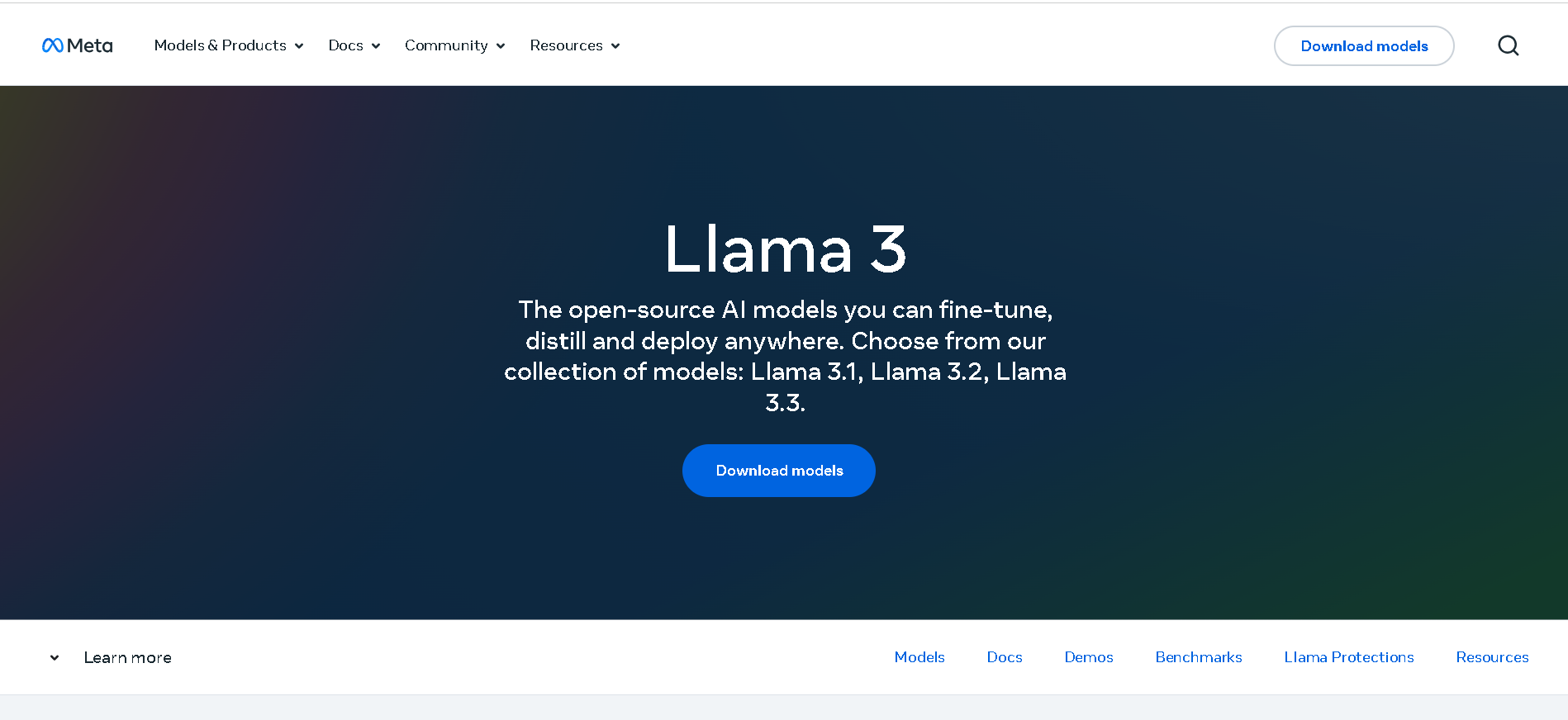
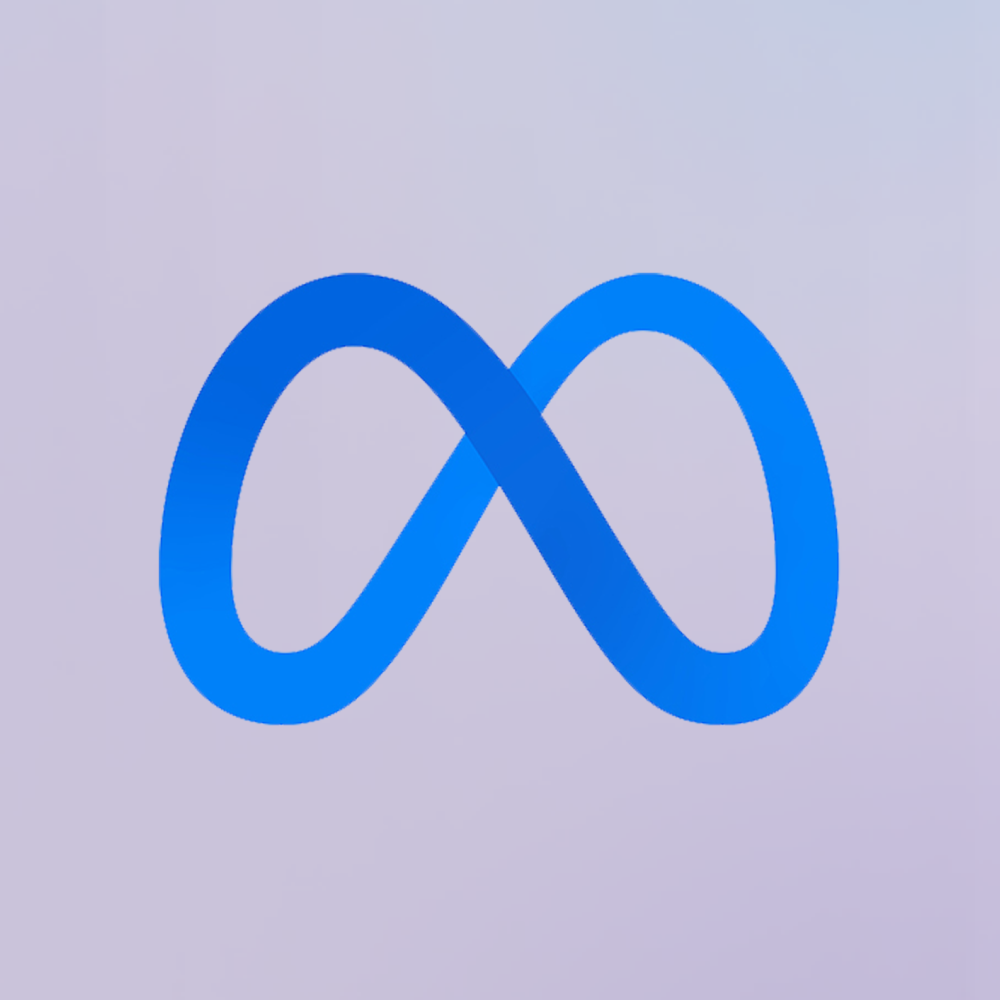
Meta Llama 3
Meta Llama 3 is Meta’s third-generation open-weight large language model family, released in April 2024 and enhanced in July 2024 with the 3.1 update. It spans three sizes—8B, 70B, and 405B parameters—each offering a 128K‑token context window. Llama 3 excels at reasoning, code generation, multilingual text, and instruction-following, and introduces multimodal vision (image understanding) capabilities in its 3.2 series. Robust safety mechanisms like Llama Guard 3, Code Shield, and CyberSec Eval 2 ensure responsible output.


Meta Llama 3
Meta Llama 3 is Meta’s third-generation open-weight large language model family, released in April 2024 and enhanced in July 2024 with the 3.1 update. It spans three sizes—8B, 70B, and 405B parameters—each offering a 128K‑token context window. Llama 3 excels at reasoning, code generation, multilingual text, and instruction-following, and introduces multimodal vision (image understanding) capabilities in its 3.2 series. Robust safety mechanisms like Llama Guard 3, Code Shield, and CyberSec Eval 2 ensure responsible output.


Meta Llama 3
Meta Llama 3 is Meta’s third-generation open-weight large language model family, released in April 2024 and enhanced in July 2024 with the 3.1 update. It spans three sizes—8B, 70B, and 405B parameters—each offering a 128K‑token context window. Llama 3 excels at reasoning, code generation, multilingual text, and instruction-following, and introduces multimodal vision (image understanding) capabilities in its 3.2 series. Robust safety mechanisms like Llama Guard 3, Code Shield, and CyberSec Eval 2 ensure responsible output.
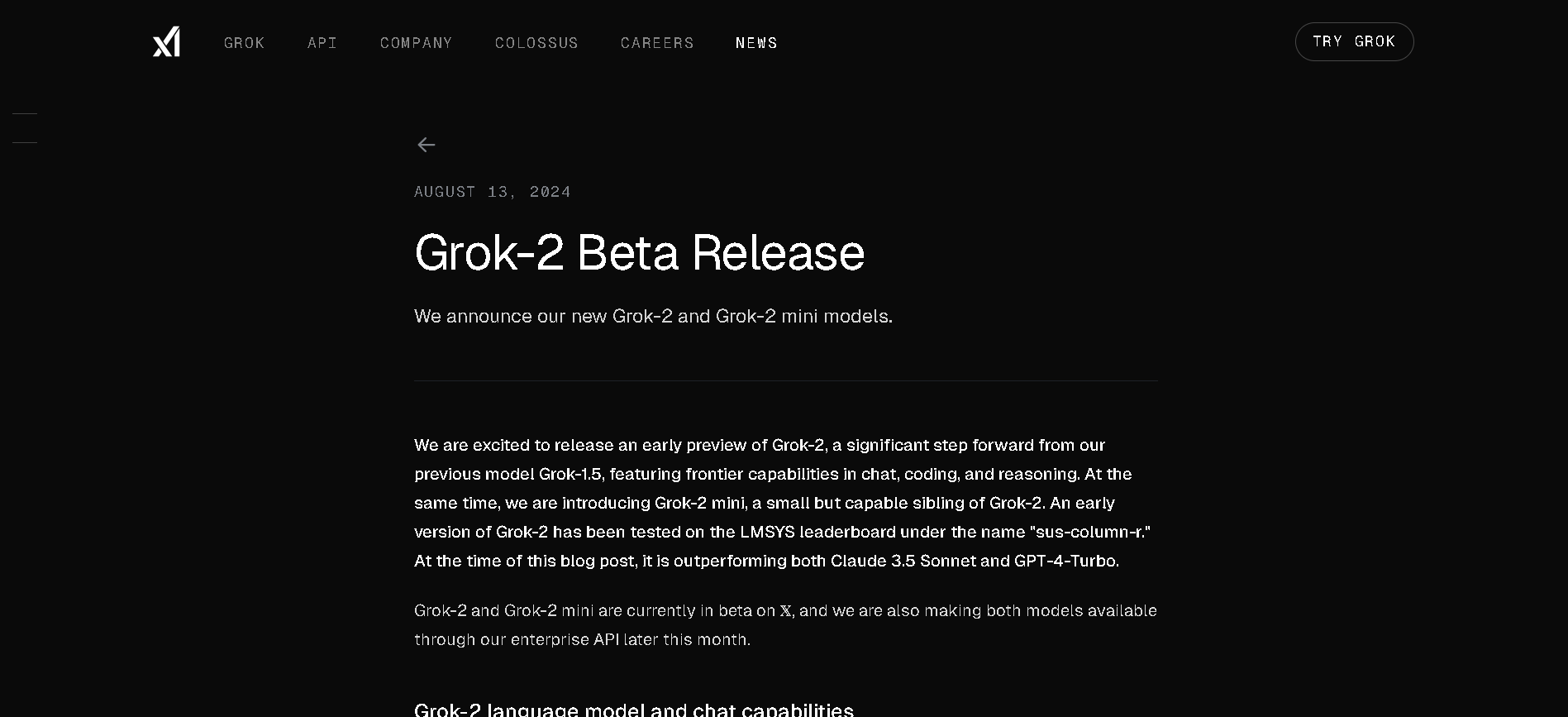
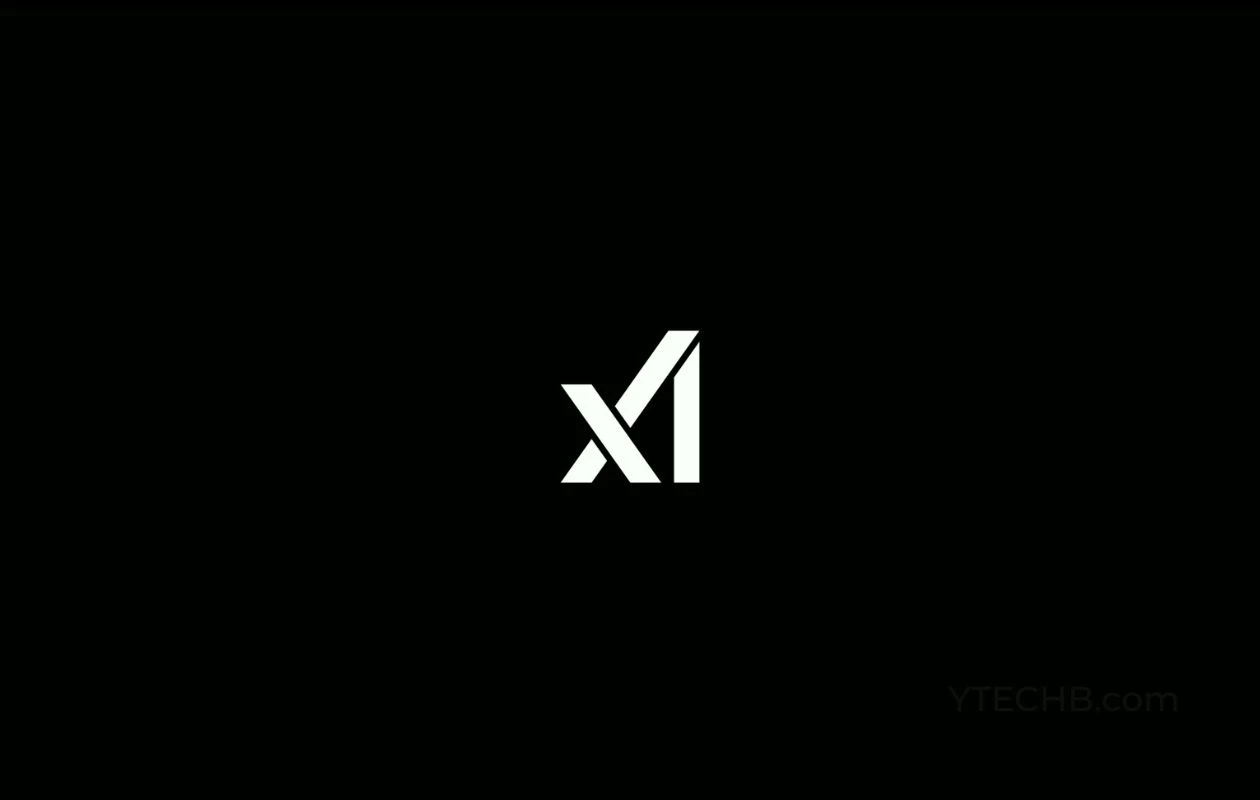
grok-2-vision
Grok 2 Vision (also known as Grok‑2‑Vision‑1212 or grok‑2‑vision‑latest) is xAI’s multimodal variant of Grok 2, designed specifically for advanced image understanding and generation. Launched in December 2024, it supports joint text+image inputs up to 32,768 tokens, excelling in visual math reasoning (MathVista), document question answering (DocVQA), object recognition, and style analysis—while also offering photorealistic image creation via the FLUX.1 model.


grok-2-vision
Grok 2 Vision (also known as Grok‑2‑Vision‑1212 or grok‑2‑vision‑latest) is xAI’s multimodal variant of Grok 2, designed specifically for advanced image understanding and generation. Launched in December 2024, it supports joint text+image inputs up to 32,768 tokens, excelling in visual math reasoning (MathVista), document question answering (DocVQA), object recognition, and style analysis—while also offering photorealistic image creation via the FLUX.1 model.


grok-2-vision
Grok 2 Vision (also known as Grok‑2‑Vision‑1212 or grok‑2‑vision‑latest) is xAI’s multimodal variant of Grok 2, designed specifically for advanced image understanding and generation. Launched in December 2024, it supports joint text+image inputs up to 32,768 tokens, excelling in visual math reasoning (MathVista), document question answering (DocVQA), object recognition, and style analysis—while also offering photorealistic image creation via the FLUX.1 model.
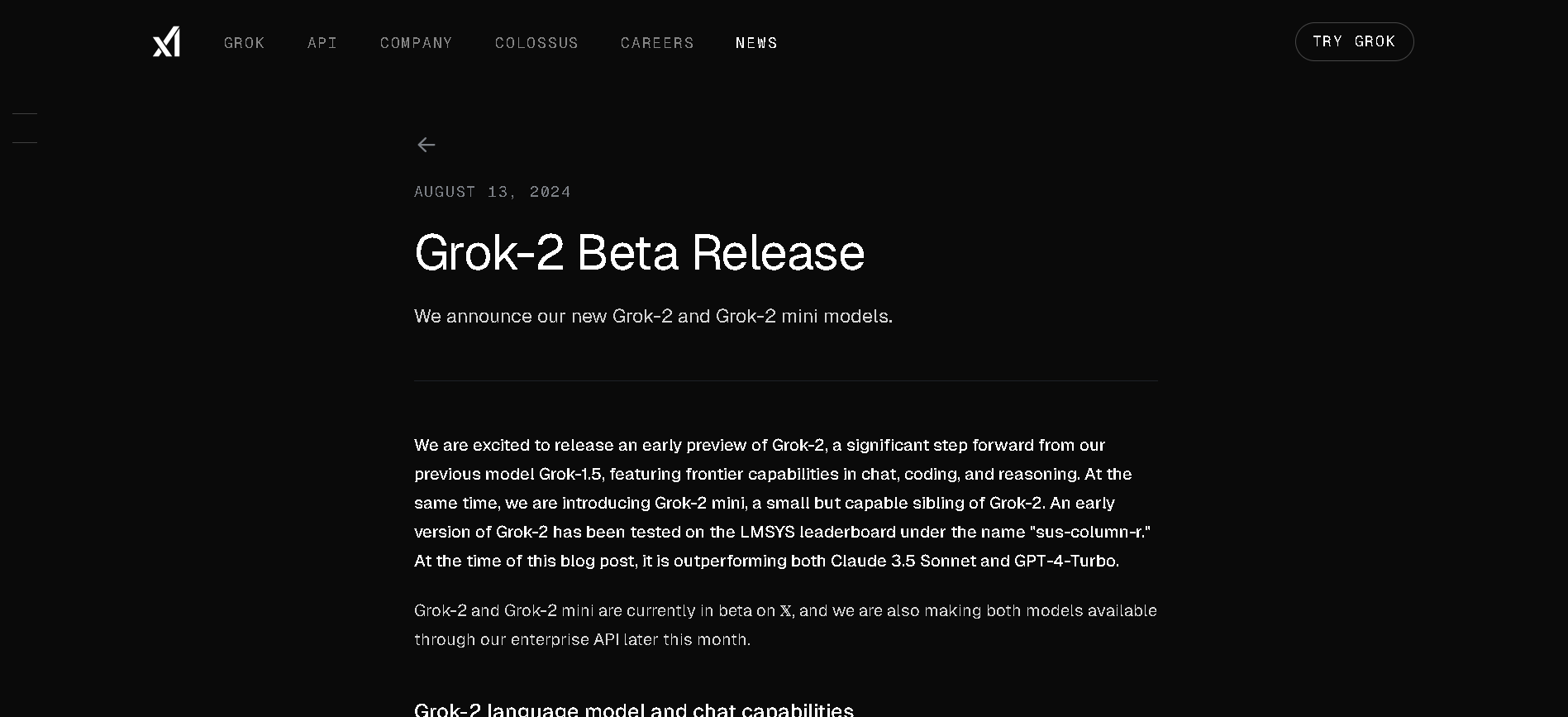
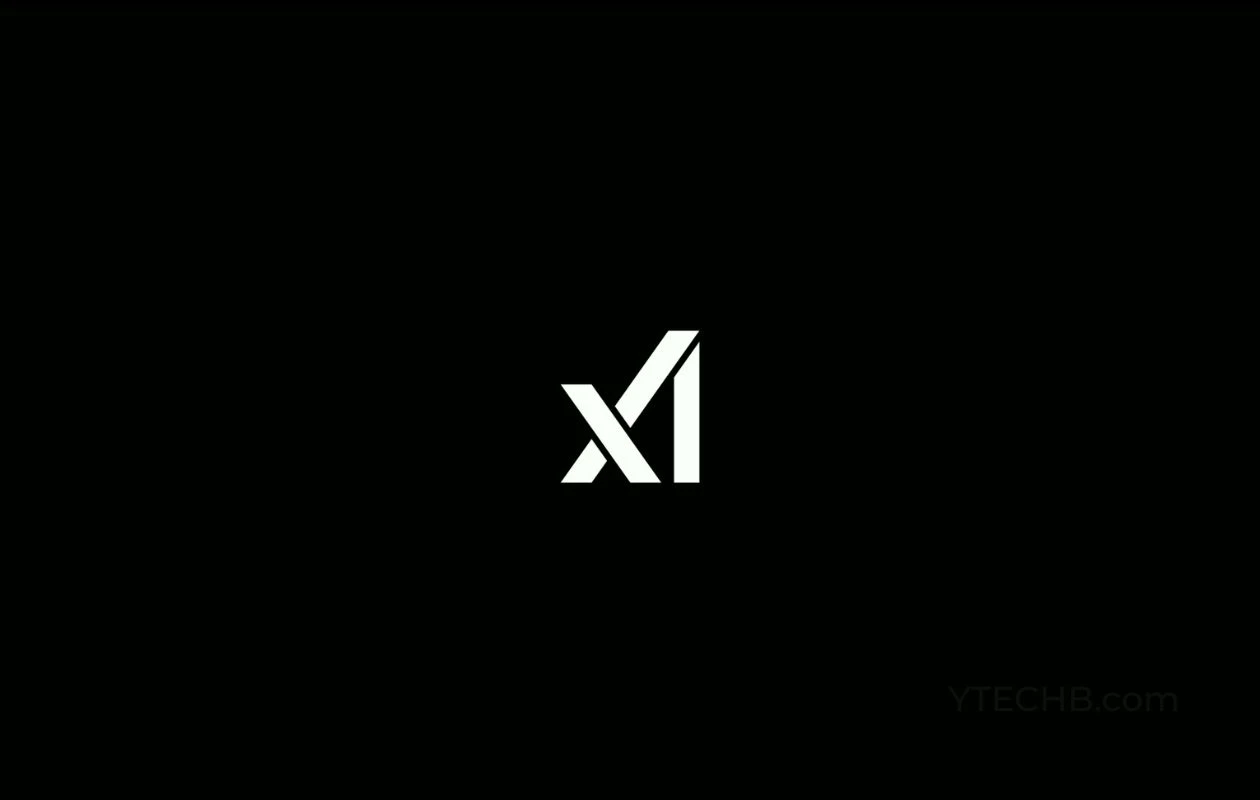
grok-2-vision-late..
Grok 2 Vision is xAI’s advanced vision-enabled variant of Grok 2, launched in December 2024. It supports joint text + image inputs with a 32K-token context window, combining image understanding, document QA, visual math reasoning (e.g., MathVista, DocVQA), and photorealistic image generation via FLUX.1 (later complemented by Aurora). It scores state-of-the-art on multimodal tasks.


grok-2-vision-late..
Grok 2 Vision is xAI’s advanced vision-enabled variant of Grok 2, launched in December 2024. It supports joint text + image inputs with a 32K-token context window, combining image understanding, document QA, visual math reasoning (e.g., MathVista, DocVQA), and photorealistic image generation via FLUX.1 (later complemented by Aurora). It scores state-of-the-art on multimodal tasks.


grok-2-vision-late..
Grok 2 Vision is xAI’s advanced vision-enabled variant of Grok 2, launched in December 2024. It supports joint text + image inputs with a 32K-token context window, combining image understanding, document QA, visual math reasoning (e.g., MathVista, DocVQA), and photorealistic image generation via FLUX.1 (later complemented by Aurora). It scores state-of-the-art on multimodal tasks.
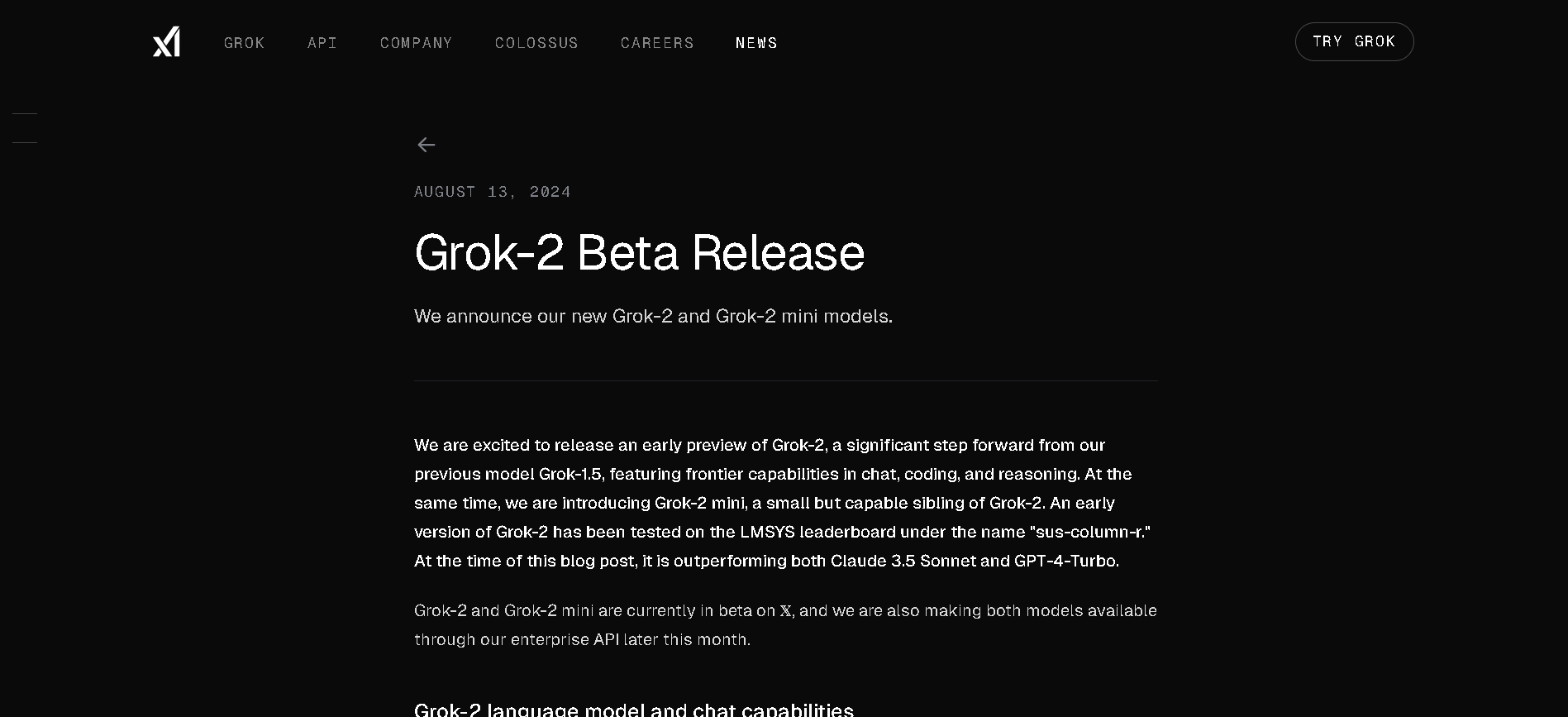
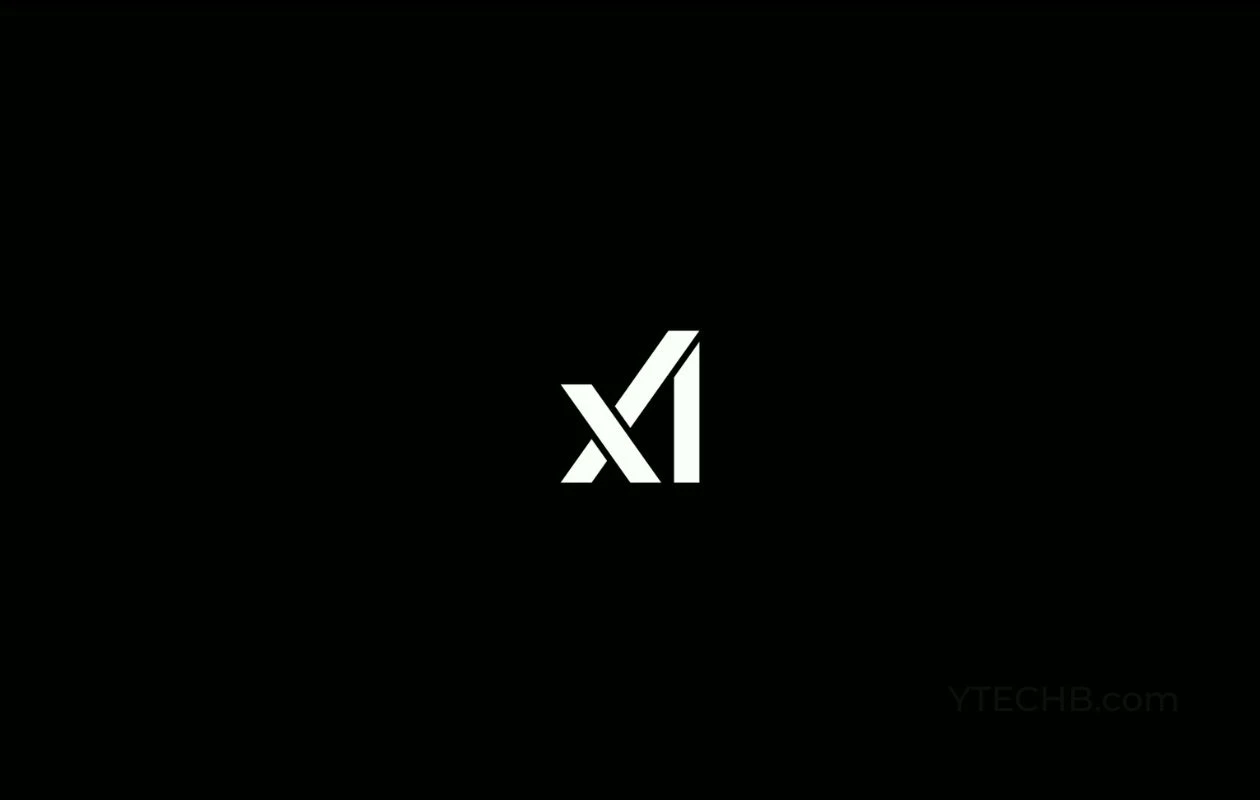
grok-2-vision-1212
Grok 2 Vision – 1212 is a December 2024 release of xAI’s multimodal large language model, fine-tuned specifically for image understanding and generation. It supports combined text and image inputs (up to 32,768 tokens) and excels in document question answering, visual math reasoning, object recognition, and photorealistic image generation powered by FLUX.1. It also supports API deployment for developers and enterprises.


grok-2-vision-1212
Grok 2 Vision – 1212 is a December 2024 release of xAI’s multimodal large language model, fine-tuned specifically for image understanding and generation. It supports combined text and image inputs (up to 32,768 tokens) and excels in document question answering, visual math reasoning, object recognition, and photorealistic image generation powered by FLUX.1. It also supports API deployment for developers and enterprises.


grok-2-vision-1212
Grok 2 Vision – 1212 is a December 2024 release of xAI’s multimodal large language model, fine-tuned specifically for image understanding and generation. It supports combined text and image inputs (up to 32,768 tokens) and excels in document question answering, visual math reasoning, object recognition, and photorealistic image generation powered by FLUX.1. It also supports API deployment for developers and enterprises.
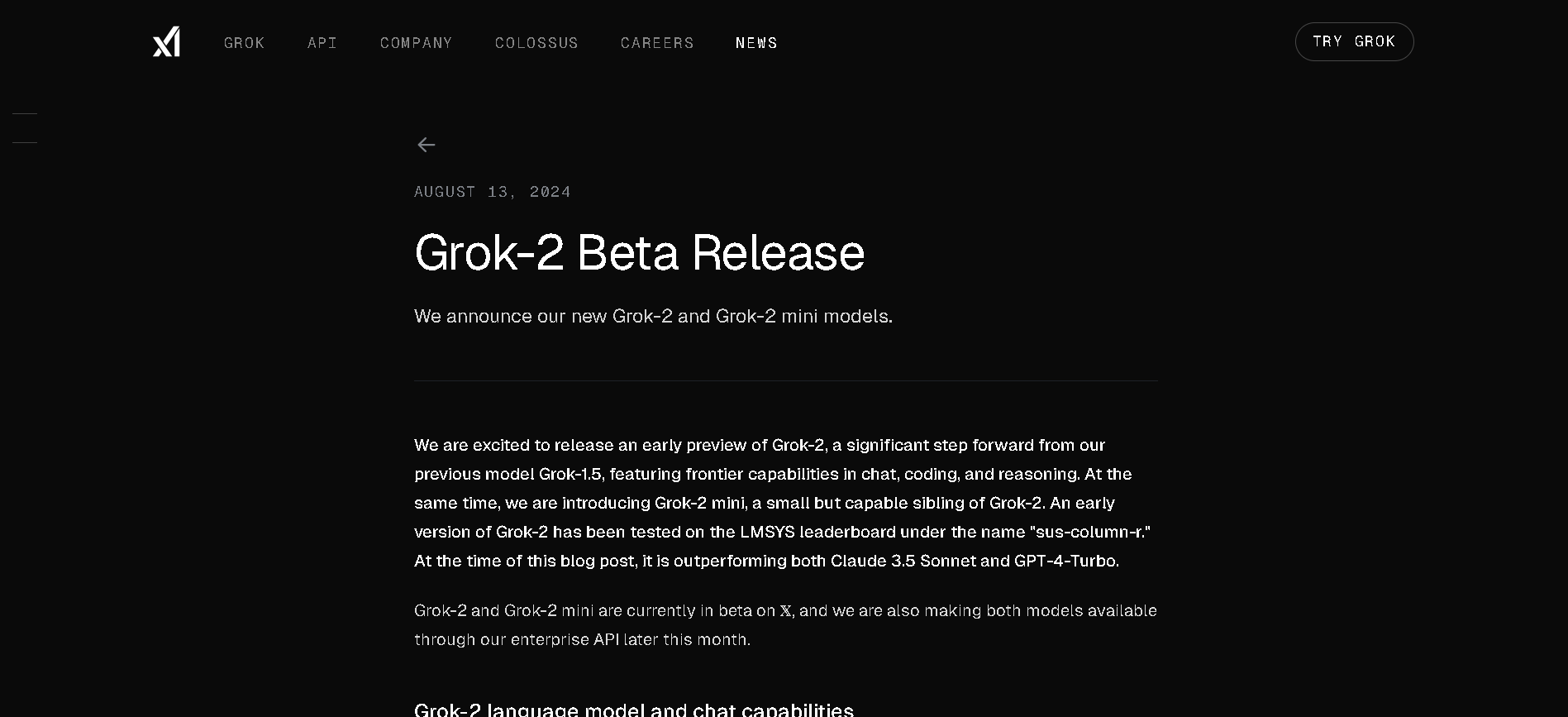
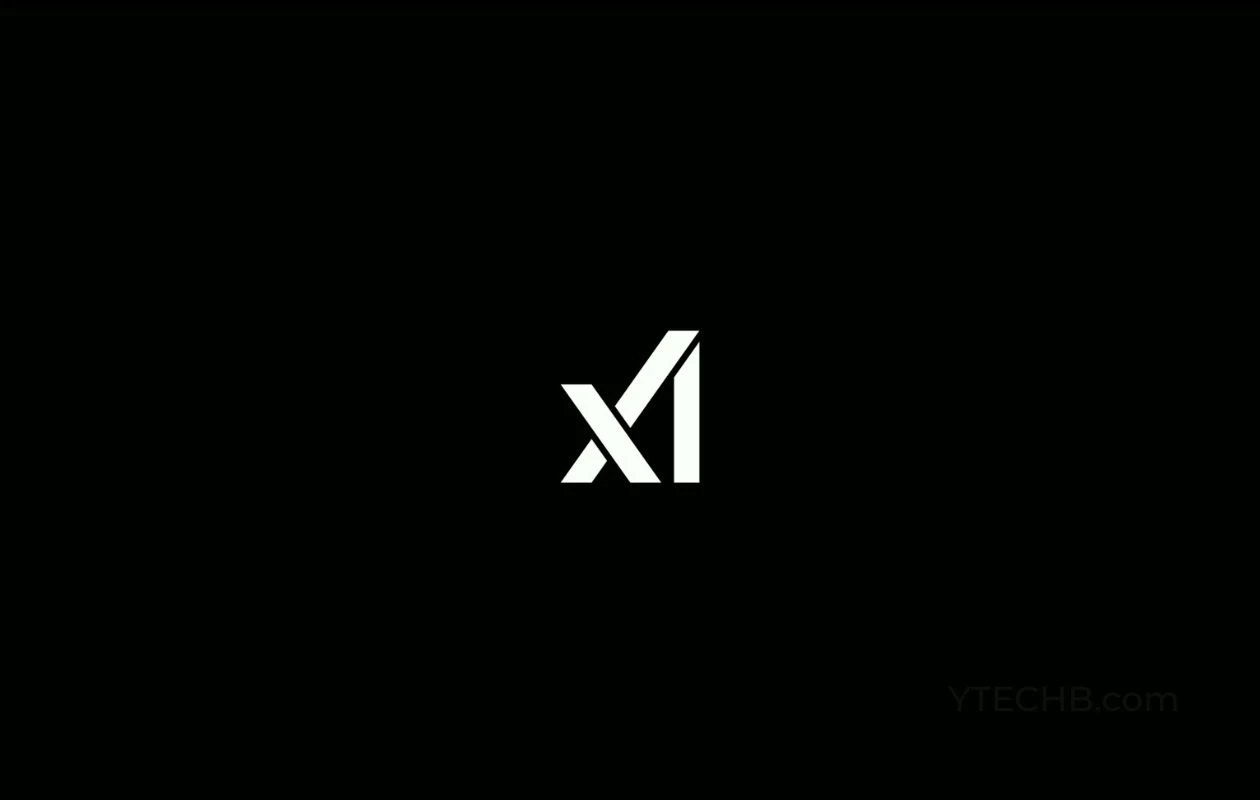
grok-2-image-1212
Grok 2 Image 1212 (also known as grok-2-image-1212) is xAI’s December 2024 release of their unified image generation and understanding model. Built on Grok 2, it combines Aurora-powered photorealistic image creation with strong multimodal comprehension—handling image editing, vision QA, chart interpretation, and document analysis—within a single API and 32,768-token context.


grok-2-image-1212
Grok 2 Image 1212 (also known as grok-2-image-1212) is xAI’s December 2024 release of their unified image generation and understanding model. Built on Grok 2, it combines Aurora-powered photorealistic image creation with strong multimodal comprehension—handling image editing, vision QA, chart interpretation, and document analysis—within a single API and 32,768-token context.


grok-2-image-1212
Grok 2 Image 1212 (also known as grok-2-image-1212) is xAI’s December 2024 release of their unified image generation and understanding model. Built on Grok 2, it combines Aurora-powered photorealistic image creation with strong multimodal comprehension—handling image editing, vision QA, chart interpretation, and document analysis—within a single API and 32,768-token context.
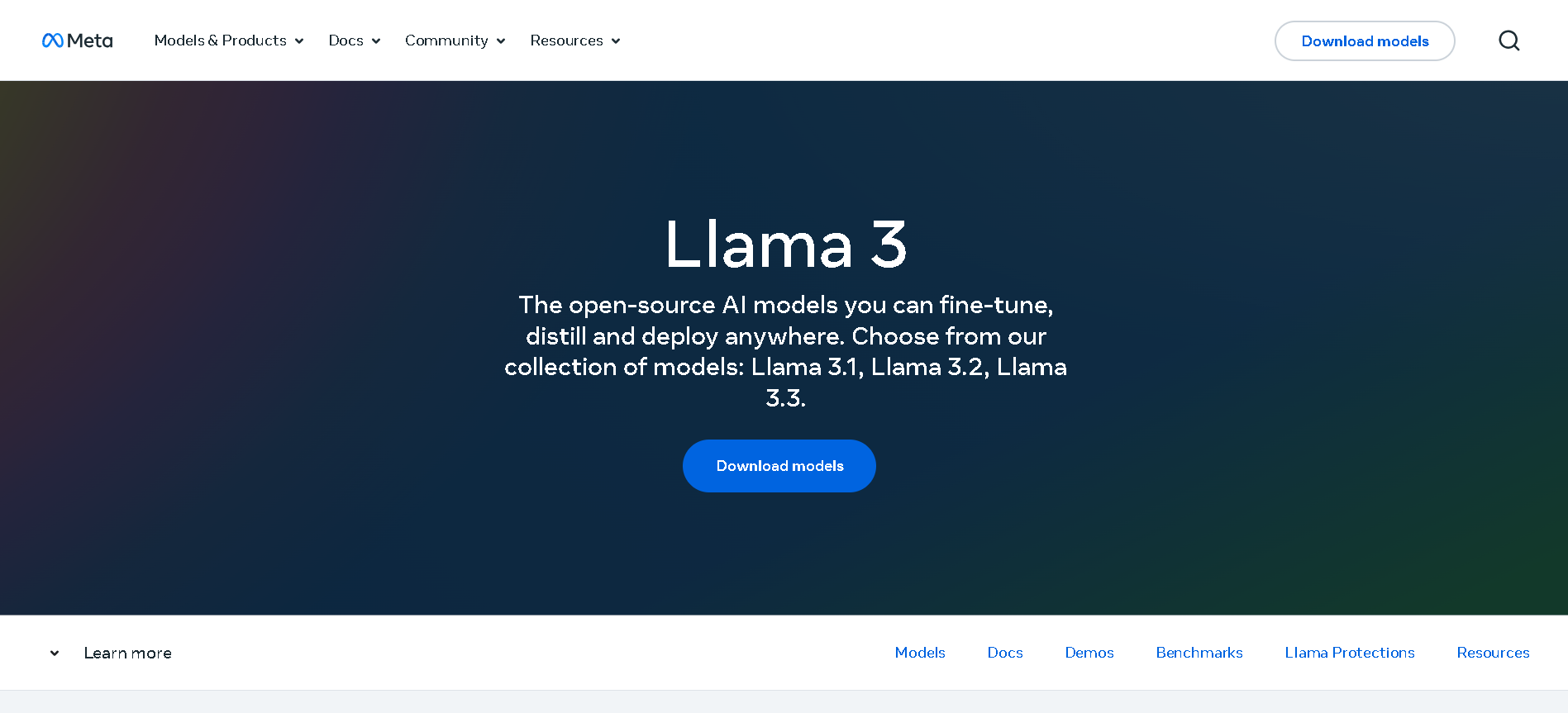

Meta Llama 3.1
Llama 3.1 is Meta’s most advanced open-source Llama 3 model, released on July 23, 2024. It comes in three sizes—8B, 70B, and 405B parameters—with an expanded 128K-token context window and improved multilingual and multimodal capabilities. It significantly outperforms Llama 3 and rivals proprietary models across benchmarks like GSM8K, MMLU, HumanEval, ARC, and tool-augmented reasoning tasks.


Meta Llama 3.1
Llama 3.1 is Meta’s most advanced open-source Llama 3 model, released on July 23, 2024. It comes in three sizes—8B, 70B, and 405B parameters—with an expanded 128K-token context window and improved multilingual and multimodal capabilities. It significantly outperforms Llama 3 and rivals proprietary models across benchmarks like GSM8K, MMLU, HumanEval, ARC, and tool-augmented reasoning tasks.


Meta Llama 3.1
Llama 3.1 is Meta’s most advanced open-source Llama 3 model, released on July 23, 2024. It comes in three sizes—8B, 70B, and 405B parameters—with an expanded 128K-token context window and improved multilingual and multimodal capabilities. It significantly outperforms Llama 3 and rivals proprietary models across benchmarks like GSM8K, MMLU, HumanEval, ARC, and tool-augmented reasoning tasks.
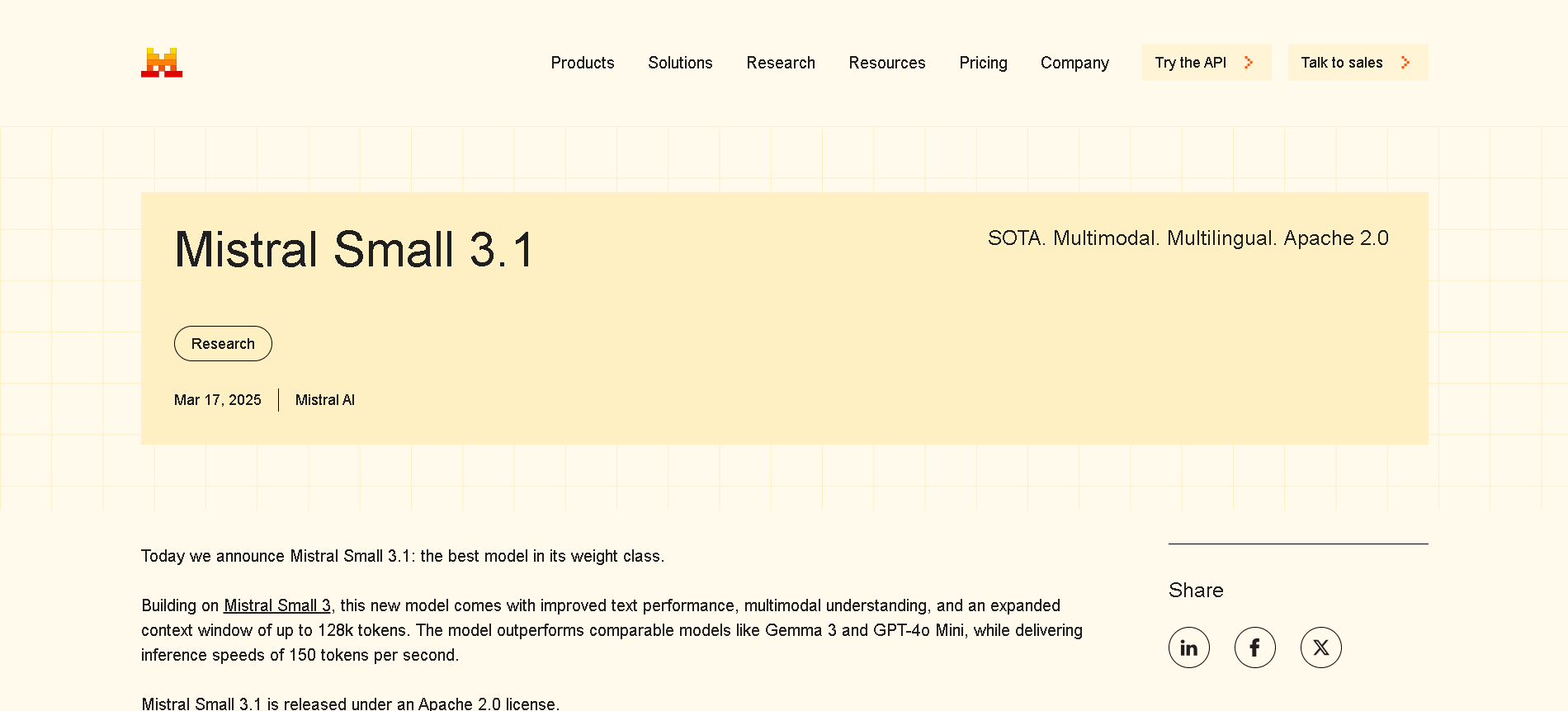
Mistral Small 3.1
Mistral Small 3.1 is the March 17, 2025 update to Mistral AI's open-source 24B-parameter small model. It offers instruction-following, multimodal vision understanding, and an expanded 128K-token context window, delivering performance on par with or better than GPT‑4o Mini, Gemma 3, and Claude 3.5 Haiku—all while maintaining fast inference speeds (~150 tokens/sec) and running on devices like an RTX 4090 or a 32 GB Mac.

Mistral Small 3.1
Mistral Small 3.1 is the March 17, 2025 update to Mistral AI's open-source 24B-parameter small model. It offers instruction-following, multimodal vision understanding, and an expanded 128K-token context window, delivering performance on par with or better than GPT‑4o Mini, Gemma 3, and Claude 3.5 Haiku—all while maintaining fast inference speeds (~150 tokens/sec) and running on devices like an RTX 4090 or a 32 GB Mac.

Mistral Small 3.1
Mistral Small 3.1 is the March 17, 2025 update to Mistral AI's open-source 24B-parameter small model. It offers instruction-following, multimodal vision understanding, and an expanded 128K-token context window, delivering performance on par with or better than GPT‑4o Mini, Gemma 3, and Claude 3.5 Haiku—all while maintaining fast inference speeds (~150 tokens/sec) and running on devices like an RTX 4090 or a 32 GB Mac.
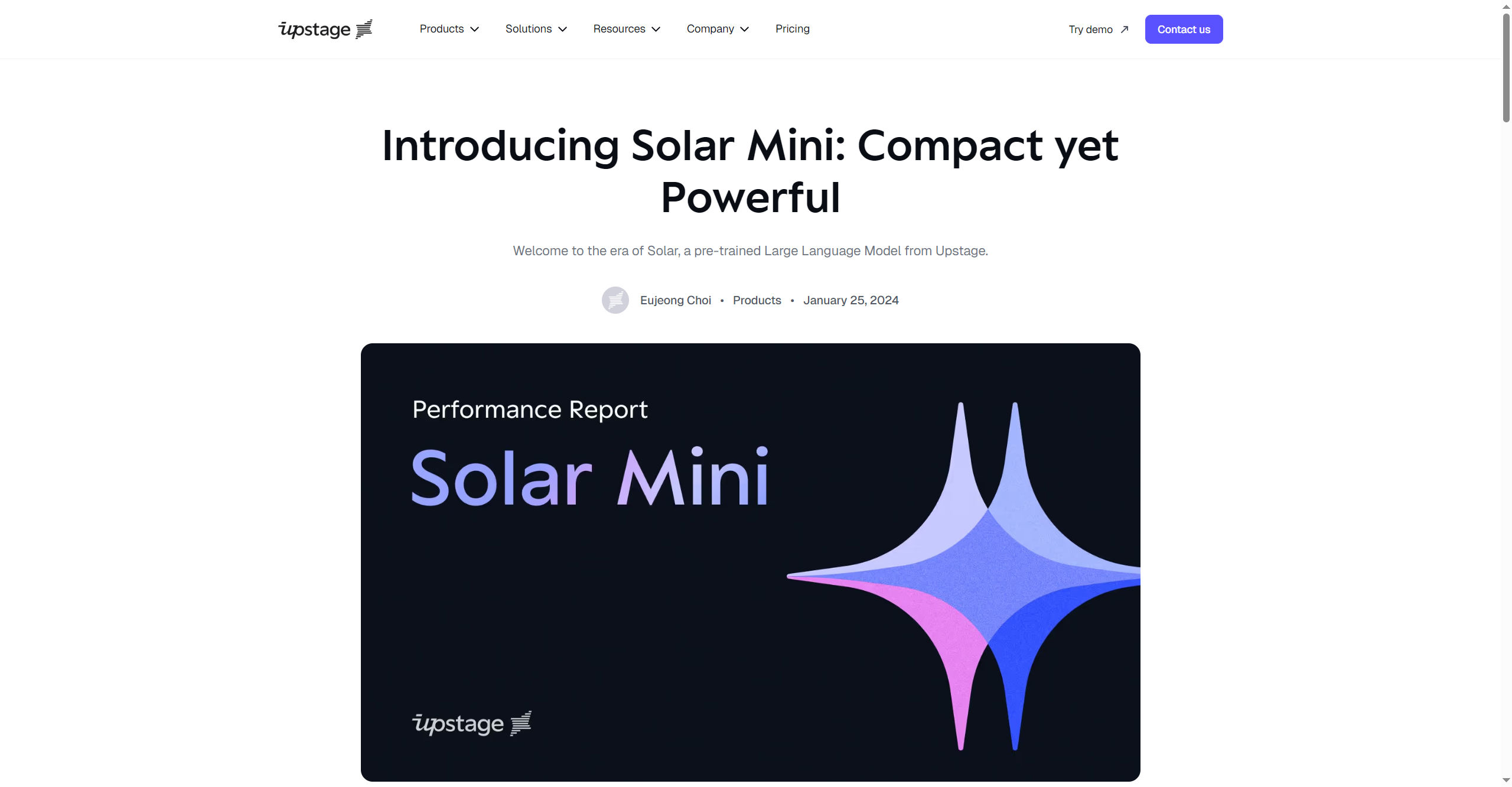

Upstage - Solar Mi..
Solar Mini is Upstage’s compact, high-performance large language model (LLM) with under 30 billion parameters, engineered for exceptional speed and efficiency without sacrificing quality. It outperforms comparable models like Llama2, Mistral 7B, and Ko-Alpaca on major benchmarks, delivering responses similar to GPT-3.5 but 2.5 times faster. Thanks to its innovative Depth Up-scaling (DUS) and continued pre-training, Solar Mini is easily customized for domain-specific tasks, supports on-device deployment, and is especially suited for decentralized, responsive AI applications.


Upstage - Solar Mi..
Solar Mini is Upstage’s compact, high-performance large language model (LLM) with under 30 billion parameters, engineered for exceptional speed and efficiency without sacrificing quality. It outperforms comparable models like Llama2, Mistral 7B, and Ko-Alpaca on major benchmarks, delivering responses similar to GPT-3.5 but 2.5 times faster. Thanks to its innovative Depth Up-scaling (DUS) and continued pre-training, Solar Mini is easily customized for domain-specific tasks, supports on-device deployment, and is especially suited for decentralized, responsive AI applications.


Upstage - Solar Mi..
Solar Mini is Upstage’s compact, high-performance large language model (LLM) with under 30 billion parameters, engineered for exceptional speed and efficiency without sacrificing quality. It outperforms comparable models like Llama2, Mistral 7B, and Ko-Alpaca on major benchmarks, delivering responses similar to GPT-3.5 but 2.5 times faster. Thanks to its innovative Depth Up-scaling (DUS) and continued pre-training, Solar Mini is easily customized for domain-specific tasks, supports on-device deployment, and is especially suited for decentralized, responsive AI applications.
Editorial Note
This page was researched and written by the ATB Editorial Team. Our team researches each AI tool by reviewing its official website, testing features, exploring real use cases, and considering user feedback. Every page is fact-checked and regularly updated to ensure the information stays accurate, neutral, and useful for our readers.
If you have any suggestions or questions, email us at hello@aitoolbook.ai
